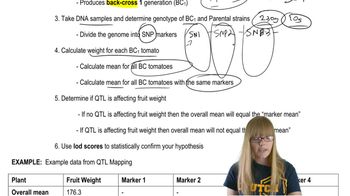Both QTL mapping and association mapping are used to locate genes responsible for a phenotype. Which of the following typically tests two differing alleles between the parents of a mapping population?
Table of contents
- 1. Introduction to Genetics51m
- 2. Mendel's Laws of Inheritance3h 37m
- 3. Extensions to Mendelian Inheritance2h 41m
- 4. Genetic Mapping and Linkage2h 28m
- 5. Genetics of Bacteria and Viruses1h 21m
- 6. Chromosomal Variation1h 48m
- 7. DNA and Chromosome Structure56m
- 8. DNA Replication1h 10m
- 9. Mitosis and Meiosis1h 34m
- 10. Transcription1h 0m
- 11. Translation58m
- 12. Gene Regulation in Prokaryotes1h 19m
- 13. Gene Regulation in Eukaryotes44m
- 14. Genetic Control of Development44m
- 15. Genomes and Genomics1h 50m
- 16. Transposable Elements47m
- 17. Mutation, Repair, and Recombination1h 6m
- 18. Molecular Genetic Tools19m
- 19. Cancer Genetics29m
- 20. Quantitative Genetics1h 26m
- 21. Population Genetics50m
- 22. Evolutionary Genetics29m
20. Quantitative Genetics
QTL Mapping
Problem 20b
Textbook Question
Many traits of economic or medical significance are determined by quantitative trait loci (QTLs) in which many genes, usually scattered throughout the genome, contribute to expression.
What is meant by the term cosegregate in the context of QTL mapping? Why are markers such as RFLPs, SNPs, and microsatellites often used in QTL mapping?
 Verified step by step guidance
Verified step by step guidance1
Step 1: Define the term 'cosegregate' in the context of QTL mapping. Cosegregation refers to the phenomenon where a genetic marker and a trait of interest are inherited together in offspring due to their physical proximity on the same chromosome. This linkage suggests that the marker is near a gene influencing the trait.
Step 2: Explain the importance of genetic markers in QTL mapping. Genetic markers, such as RFLPs (Restriction Fragment Length Polymorphisms), SNPs (Single Nucleotide Polymorphisms), and microsatellites, are used to identify regions of the genome associated with specific traits. These markers act as signposts to locate genes contributing to quantitative traits.
Step 3: Discuss why RFLPs are useful in QTL mapping. RFLPs are variations in DNA sequences that can be detected by restriction enzymes. They are valuable because they provide a way to distinguish between different alleles at a locus, aiding in the identification of linked traits.
Step 4: Explain the role of SNPs in QTL mapping. SNPs are single base-pair changes in the DNA sequence and are highly abundant throughout the genome. Their high density makes them ideal for fine-scale mapping of QTLs, as they can pinpoint regions associated with traits more precisely.
Step 5: Describe the significance of microsatellites in QTL mapping. Microsatellites are short, repetitive DNA sequences that vary in length between individuals. Their high variability and ease of detection make them useful for tracking inheritance patterns and identifying genomic regions linked to quantitative traits.
 Verified video answer for a similar problem:
Verified video answer for a similar problem:This video solution was recommended by our tutors as helpful for the problem above
Video duration:
1mPlay a video:
Was this helpful?
Key Concepts
Here are the essential concepts you must grasp in order to answer the question correctly.
Cosegregation
Cosegregation refers to the phenomenon where two or more genetic markers or traits are inherited together more often than would be expected by chance. In the context of QTL mapping, it indicates that a specific marker is linked to a trait of interest, allowing researchers to track the inheritance of that trait through generations. This is crucial for identifying the genetic basis of quantitative traits.
Quantitative Trait Loci (QTL)
Quantitative Trait Loci (QTL) are regions of the genome that are associated with the variation in a quantitative trait, which is a trait that can be measured and is influenced by multiple genes. QTL mapping helps identify these regions by correlating phenotypic data with genetic markers, enabling researchers to understand the genetic architecture of complex traits, such as height or disease susceptibility.
Recommended video:
Guided course

QTL Mapping
Genetic Markers (RFLPs, SNPs, Microsatellites)
Genetic markers like Restriction Fragment Length Polymorphisms (RFLPs), Single Nucleotide Polymorphisms (SNPs), and microsatellites are used in QTL mapping to identify specific locations in the genome associated with traits. These markers are valuable because they are abundant, easily detectable, and can provide high-resolution mapping of QTLs, facilitating the understanding of genetic contributions to traits of interest.
Recommended video:
Guided course

Mapping with Markers
Related Videos
Related Practice
Multiple Choice
462
views


